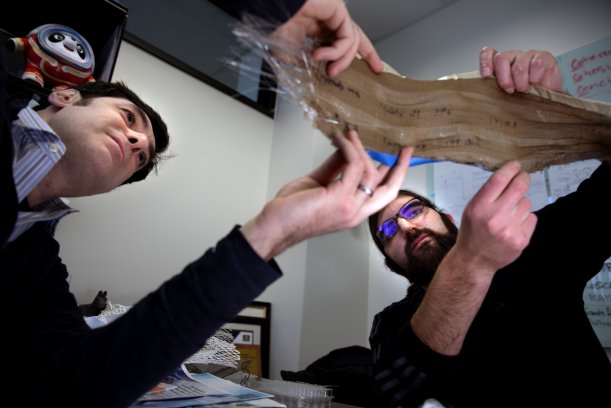
Improving quality of life for butterfly children with Tencel
Combination of two materials bends and refracts light to create optical effects that can look like colour.

6th February 2023
Innovation in Textiles
|
Ann Arbor, MI, USA
Less than 15% of the 92 million tons of clothing and other textiles discarded annually are recycled, in part because they are so difficult to sort. Woven-in labels made with inexpensive photonic fibres developed by a University of Michigan-led team could prove a game changer in this respect.
“It’s like a barcode that’s woven directly into the fabric of a garment,” said Max Shtein, a UM professor of materials science and engineering. “We can customise the photonic properties of the fibres to make them visible to the naked eye, readable only under near-infrared light or any combination.”
Ordinary tags often don’t make it to the end of a garment’s life – they can be cut away or washed until illegible, and tagless information can wear off. Recycling could be more effective if a tag was woven into the fabric, invisible until it needs to be read.

Recyclers already use near-infrared sorting systems that identify different materials according to their naturally-occurring optical signatures – the PET plastic in a water bottle, for example, looks different under near-infrared light to the HDPE plastic in a milk bottle. Different fabrics also have different optical signatures, but Brian Iezzi, a postdoctoral researcher in Shtein’s lab, explained that these signatures are of limited use to recyclers because of the prevalence of blended fabrics.
“For a truly circular recycling system to work, it’s important to know the precise composition of a fabric – a cotton recycler doesn’t want to pay for a garment that’s made of 70% polyester,” he said. “Natural optical signatures can’t provide that level of precision, but our photonic fibres can.”
The team developed the technology by combining photonic expertise – usually applied to products like displays, solar cells and optical filters – with the advanced textile capabilities at MIT’s Lincoln Lab. The lab worked to incorporate the photonic properties into a process that would be compatible with large-scale production.

They accomplished this by starting with a preform – a plastic feedstock that comprises dozens of alternating layers. In this case, they used acrylic and polycarbonate. While each individual layer is clear, the combination of two materials bends and refracts light to create optical effects that can look like colour. It’s the same basic phenomena that gives butterfly wings their shimmer.
The preform is heated and then mechanically pulled into a hair-thin strand of fibre. While the manufacturing process method differs from the extrusion technique used to make conventional synthetic fibres like polyester, it can produce the same miles-long strands which can then be processed with the same equipment already used by textile makers.
Tuning
By adjusting the mix of materials and the speed at which the preform is pulled, the researchers tuned the fibre to create the desired optical properties and ensure recyclability. While the photonic fibre is more expensive than traditional textiles, the researchers estimate that it will only result in a small increase in the cost of finished goods.
“The photonic fibres only need to make up a small percentage – as little as 1% of a finished garment,” Iezzi said. “That might increase the cost of the finished product by around 25 cents, which is similar to the cost of the use-and-care tags we’re all familiar with.”
Shtein says that in addition to making recycling easier, the photonic labelling could be used to tell consumers where and how goods are made, and even to verify the authenticity of brand-name products.
“As electronic devices like cell phones become more sophisticated, they could potentially have the ability to read this kind of photonic labelling, so I could imagine a future where woven-in labels are a useful feature for consumers as well as recyclers.”
The team has applied for patent protection and is evaluating ways to move forward with the commercialisation of the technology.
The research was supported by the US National Science Foundation and the Under Secretary of Defense for Research and Engineering.

Business intelligence for the fibre, textiles and apparel industries: technologies, innovations, markets, investments, trade policy, sourcing, strategy...
Find out more